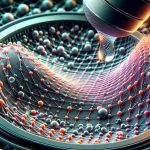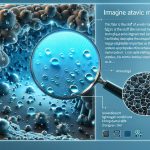When you think about fabrics, you probably imagine comfort and style, but nanotechnology is changing the game. By incorporating nanoparticles into textile fibers, manufacturers enhance durability, stain resistance, and breathability without sacrificing comfort. Imagine clothes that repel water, kill bacteria, and protect you from UV rays—sounds impressive, right? But with these advancements come questions about environmental impact and safety. How are these tiny particles transforming textiles, and what should you consider before making your next purchase? Let's explore the fascinating world of nanotechnology in fabrics and uncover what you really need to know.
Table of Contents
Key Takeaways
- Enhanced Fabric Performance: Nanotechnology improves durability, stain resistance, and comfort without compromising the fabric's texture or breathability.
- Environmental Impact: The production and disposal of nanotechnology-enhanced fabrics pose challenges for sustainability and environmental health.
- Smart Fabrics: Integration of sensors and actuators in nanofabrics offers real-time health monitoring and adaptive clothing features.
- Types of Nanomaterials: Common nanomaterials include silver nanoparticles for antimicrobial properties and carbon nanotubes for strength and conductivity.
- Safety Concerns: Proper risk assessments and consumer education are essential to address potential health and environmental risks of nanotechnology in fabrics.
Understanding Nanotechnology
To understand how nanotechnology transforms fabrics, you first need to grasp what nanotechnology actually is.
Nanotechnology involves manipulating materials at the nanoscale, typically less than 100 nanometers. At this minuscule scale, materials exhibit unique physical and chemical properties. This manipulation allows for innovative nanotechnology applications that revolutionize various industries, including textiles.
In the context of fabrics, nanotechnology enables advanced fabric treatment techniques that enhance material performance.
For instance, by embedding nanoparticles into fabric fibers, you can create textiles that are water-repellent, stain-resistant, or even antimicrobial. These enhancements don't affect the fabric's texture or breathability, making them ideal for everyday use and specialized applications alike.
Moreover, fabric treatment techniques using nanotechnology can improve durability and comfort.
By applying nanocoatings, fabrics become more resistant to wear and tear while maintaining a soft feel. This means your garments can last longer and perform better under various conditions.
Understanding these fundamental aspects of nanotechnology is essential for mastering its potential and appreciating how it transforms the fabrics you use daily. So, by grasping these concepts, you're well on your way to becoming proficient in the field of nanotechnology in fabrics.
Applications in Textiles
When you think about nanotechnology in textiles, you'll quickly see its impact on fabric durability, stain resistance, and comfort.
Imagine clothing that lasts longer, repels stains, and feels better against your skin.
These are just a few ways nanotechnology is revolutionizing what you wear every day.
Enhanced Durability
Nanotechnology greatly enhances fabric durability, making your clothes last longer and withstand wear and tear. This not only provides longevity benefits but also aligns with sustainable practices. By integrating nanoparticles into textile fibers, fabrics become more resistant to physical stress, reducing the need for frequent replacements.
Imagine the longevity benefits like this:
| Feature | Traditional Fabric | Nanotech-Enhanced Fabric |
|---|---|---|
| Wear Resistance | Moderate | High |
| Tear Strength | Standard | Superior |
| Color Retention | Fades over time | Long-lasting |
| Maintenance Needs | Frequent | Minimal |
You'll appreciate the sustainable practices that nanotechnology brings to the table. Enhanced durability means fewer resources are consumed over time, and you'll reduce waste by not discarding worn-out clothes as often. This aligns perfectly with a more eco-friendly lifestyle.
Moreover, nanotech-enhanced fabrics can handle daily activities without showing signs of wear. Whether you're hitting the gym or going for a hike, your apparel will maintain its integrity. By investing in these advanced textiles, you're not just getting high-performance clothing but also contributing to a more sustainable future.
Stain Resistance
Imagine never worrying about spills and stains on your clothes again, thanks to advanced nanotechnology in fabrics. With cutting-edge fabric technology, you can enjoy garments that resist stains effortlessly, keeping you looking sharp and polished. Nanoparticles integrated into the fibers create a barrier that repels liquids and dirt. This means accidental coffee spills or mud splashes won't ruin your day or your outfit.
These innovations in fabric technology aren't just about convenience; they're also about sustainability. Stain-resistant fabrics offer eco-friendly alternatives to traditional stain treatments, which often involve harsh chemicals. By adopting these sustainable solutions, you contribute to reducing the environmental footprint of your wardrobe.
Furthermore, fabric innovation in stain resistance extends the life of your clothing. When your clothes stay clean longer, you wash them less frequently, saving water, energy, and reducing wear and tear. This kind of fabric technology not only enhances your experience but also promotes a more sustainable lifestyle.
Incorporating nanotechnology into textiles represents a significant leap forward in fabric innovation. It's about merging practicality with sustainability, providing you with eco-friendly alternatives that don't compromise on style or functionality.
Embrace these advancements and revolutionize your wardrobe with stain-resistant fabrics.
Improved Comfort
Enhanced comfort in textiles is another remarkable benefit of nanotechnology, making your clothing feel softer, more breathable, and adaptable to various conditions. Imagine your favorite shirt not just fitting well, but also actively working to keep you comfortable throughout the day.
With nanotechnology, fabrics now excel in moisture wicking, guaranteeing you stay dry even during intense activities.
Here are some key aspects of how nanotechnology improves comfort in textiles:
- Moisture Wicking: Nanofibers enhance the fabric's ability to draw moisture away from your skin, keeping you dry and comfortable.
- Temperature Regulation: Advanced materials can adapt to your body's temperature, keeping you cool in the summer and warm in the winter.
- Softness: Nanotechnology allows for incredibly fine threads, resulting in fabrics that feel notably softer on your skin.
- Flexibility: Enhanced flexibility ensures your clothes move with you, providing a better fit and greater freedom of movement.
How It Works
You'll find that nanotechnology enhances fabrics through nanoscale treatments, improving their properties greatly.
These enhancements can make materials more durable, water-resistant, or even capable of sensing environmental changes.
Smart fabric applications are a growing field, integrating technology directly into textiles for innovative uses.
Nanoscale Fabric Treatment
Nanoscale fabric treatment works by embedding minuscule particles into the fibers, providing the material with enhanced properties like water resistance and increased durability. This groundbreaking approach utilizes nanoscale fabric technology to treat textiles at a molecular level, forming a protective layer that enhances the fabric's overall performance.
These treatments are particularly valuable in industrial applications where durability and function are crucial.
To achieve this:
- Nanoparticles: Coatings, often made up of nanoparticles, are applied to the textile, creating a barrier against liquids and stains.
- Bonding Techniques: Advanced bonding methods guarantee that these particles adhere securely to the fibers without compromising the fabric's breathability.
- Functionality: The treated fabric can display unique characteristics such as UV protection, anti-bacterial properties, and thermal regulation.
- Scalability: This technology can be expanded for mass production, making performance textiles accessible across various industries.
Nanofabric coating methods capitalize on the small size and high surface area of nanoparticles, allowing for efficient and uniform application. By mastering these techniques, you can create performance textiles that meet specific needs and endure challenging conditions.
Understanding how nanoscale fabric treatment works will empower you to innovate and push the boundaries of what's achievable in textile engineering.
Enhanced Material Properties
Nanotechnology's ability to modify fabric at the molecular level opens up a host of enhanced material properties that revolutionize textile performance. By incorporating nanoparticles into fibers, fabrics can achieve superior characteristics that traditional methods can't match. You'll notice that this innovative technology leverages material science to create textiles that repel water, resist stains, and even fight bacteria.
Imagine fabrics that are not only more durable but also extremely lightweight. Nanoparticles bond tightly to the fabric fibers, enhancing their strength without adding bulk. Here's a glimpse of what nanotechnology brings to the table:
| Nanotechnology Feature | Enhanced Property |
|---|---|
| Water Repellent Coating | Hydrophobic Surfaces |
| Silver Nanoparticles | Antimicrobial Activity |
| Carbon Nanotubes | Increased Tensile Strength |
| UV-Blocking Nanoparticles | UV Protection |
| Self-Cleaning Nanocoatings | Reduced Maintenance |
These advancements in material science mean you get fabrics that last longer and perform better under various conditions. Whether you're looking for clothing that keeps you dry in the rain or textiles that stay fresh longer, nanotechnology has you covered. Take advantage of these breakthroughs to elevate your wardrobe and enjoy the benefits of cutting-edge fabric innovation.
Smart Fabric Applications
Smart fabrics incorporate advanced technologies to create garments that can sense and react to environmental changes. These intelligent textiles are revolutionizing the fashion industry, offering both practical and aesthetic advancements.
Imagine wearing a jacket that adjusts its insulation based on the temperature or a shirt that monitors your heart rate. Smart fabrics achieve this by integrating nanotechnology, sensors, and microcontrollers into the textile fibers. Here's how they work:
- Sensors: Embedded sensors detect changes in the environment, such as temperature, humidity, and even UV exposure.
- Actuators: These components respond to sensor data, enabling the fabric to change its properties, like cooling down or warming up.
- Microcontrollers: Tiny computers process the data from sensors and control the actuators.
- Power sources: Flexible batteries or energy-harvesting materials power these smart systems.
In the fashion industry, designers are leveraging these technologies to create garments that aren't only stylish but also functional. Beyond aesthetics, smart fabrics offer significant health benefits.
For example, clothing that tracks essential signs can provide real-time health monitoring, potentially alerting you to issues before they become serious. Embrace this cutting-edge technology to stay ahead in both style and wellness.
Types of Nanomaterials
Nanomaterials in fabrics come in various types, each bringing unique properties and benefits to enhance textile performance. One prominent type is nanosilver, known for its antimicrobial properties. Through nanomaterial synthesis, nanosilver particles are engineered to be small enough to interact at a cellular level, guaranteeing effective protection against bacteria. This synthesis process is critical for securing fabric compatibility, allowing the particles to bond seamlessly with textile fibers without compromising comfort or durability.
Another key type is carbon nanotubes (CNTs), which are prized for their extraordinary strength and electrical conductivity. These nanomaterials are integrated into fabrics to create textiles that aren't only more durable but also capable of conducting electricity, opening avenues for wearable electronics. The synthesis of CNTs involves precise control over their structure and dimensions, ensuring they enhance fabric performance without adding significant weight or bulk.
Lastly, consider titanium dioxide nanoparticles, which impart self-cleaning and UV-protective properties to fabrics. These nanoparticles are synthesized to have a high surface area, optimizing their interaction with light and pollutants. Their compatibility with various fabric types guarantees they can be used in a wide range of applications, from outdoor gear to everyday clothing.
Benefits of Nanofabrics
You'll find that nanofabrics offer a range of impressive benefits. They enhance durability and strength, making your clothes last longer.
Plus, they improve stain resistance and provide superior comfort and breathability, ensuring you stay fresh and comfortable all day.
Enhanced Durability & Strength
Nanofabrics greatly enhance the durability and strength of textiles, ensuring they last longer under various conditions. By integrating nanotechnology into fabrics, you achieve increased longevity and enhanced performance, making your textiles more robust and reliable. The improved strength and durability of these fabrics mean they can withstand wear and tear far better than traditional materials.
Here's how nanofabrics can transform your textiles:
- Increased Longevity: Nanofabrics resist degradation from environmental factors, ensuring your garments and textiles last longer.
- Enhanced Performance: With the infusion of nanomaterials, fabrics exhibit superior resilience, maintaining their shape and integrity even after extensive use.
- Improved Strength: Nanotechnology fortifies the fibers at a molecular level, making them less prone to breaking or fraying.
- Durability: These fabrics endure tough conditions, whether it's extreme weather or heavy usage, providing you with reliable performance.
Nanofabrics offer a clear advantage if you're looking to invest in textiles that don't just look good but also stand the test of time. Embracing this innovative technology means you're opting for materials that deliver both longevity and superior functionality.
Improved Stain Resistance
Thanks to advancements in nanotechnology, your fabrics can now repel stains more effectively, keeping your garments looking fresh and clean. This transformative ability stems from innovative nanofiber technology, which integrates microscopic particles directly into the fabric. These nanoparticles create a barrier that makes liquids bead up and roll off instead of soaking in, reducing the likelihood of stains.
By incorporating eco-friendly alternatives and advanced manufacturing techniques, manufacturers can produce these high-performance textiles without compromising environmental sustainability. Unlike traditional treatments that often involve harmful chemicals, nanotechnology offers a more sustainable production process. This approach not only protects your clothes but also minimizes the ecological footprint, aligning with your commitment to a greener lifestyle.
Moreover, the application of nanotechnology in fabrics ensures long-lasting stain resistance. Conventional treatments tend to wash out over time, but nanofiber-enhanced textiles maintain their protective properties even after numerous washes. This means you can enjoy the benefits of stain-resistant clothing for much longer, making it a wise investment.
Incorporating these cutting-edge advancements, you're not just opting for cleaner clothes; you're choosing a smarter, more sustainable solution. Embrace the future of fabric technology and experience the unparalleled advantages of nanofabric stain resistance.
Superior Comfort & Breathability
With nanotechnology, fabrics not only resist stains but also offer superior comfort and breathability, enhancing your overall wearing experience. Imagine wearing a shirt that feels like a second skin, adapting to your body's needs throughout the day. Nanofabrics excel in moisture management and thermal regulation, ensuring you stay dry and comfortable regardless of the conditions.
Consider the benefits:
- Enhanced Moisture Management: Nanofibers wick away sweat efficiently, keeping you dry during intense activities.
- Optimal Thermal Regulation: These fabrics maintain a stable temperature, cooling you when it's hot and providing warmth when it's cold.
- Odor Control: Embedded nanoparticles have antimicrobial properties, preventing the growth of bacteria that cause unpleasant smells.
- Long-Lasting Freshness: Thanks to these antimicrobial properties, your clothes stay fresher for longer, reducing the need for frequent washing.
You can trust that nanotechnology in fabrics means superior comfort. Whether you're a professional athlete or a casual wearer, these innovations enhance your daily life, making every piece of clothing a blend of high performance and ultimate comfort. Embrace the future of textiles and experience the unparalleled benefits of nanofabrics.
Popular Products
Smart textiles like self-cleaning shirts and UV-protective clothing are some of the most popular products leveraging nanotechnology in fabrics. These innovations reflect current fashion trends and align with evolving consumer preferences for functionality and style. You'll find that the intersection of technology and fashion has given rise to a variety of must-have items.
Here's a quick overview of popular nanotechnology-based fabric products:
| Product | Feature |
|---|---|
| Self-Cleaning Shirts | Repels dirt and stains |
| UV-Protective Clothing | Blocks harmful UV rays |
| Temperature-Regulating Fabrics | Adjusts to body heat and environment |
| Antimicrobial Socks | Inhibits bacterial growth and odor |
These products aren't just about aesthetics; they offer practical benefits that cater to the needs of today's savvy consumers. For instance, self-cleaning shirts reduce laundry frequency, while UV-protective clothing shields you from sun damage, making them highly sought-after. Temperature-regulating fabrics keep you comfortable in any weather, and antimicrobial socks guarantee your feet stay fresh all day.
Environmental Impact
While nanotechnology in fabrics offers numerous benefits, it's important to take into account the environmental impact of these innovations. Understanding these impacts helps you make informed decisions and advance in your mastery of sustainable practices.
One significant issue is the ecological footprint left by the production and disposal of nanomaterials. These tiny particles can persist in the environment, potentially disrupting ecosystems and affecting biodiversity.
Additionally, recycling challenges arise when dealing with nanotechnology-infused fabrics. Traditional recycling methods may not be effective for materials enhanced with nanoparticles, complicating the recycling process and potentially leading to an increase in textile waste.
To maintain a sustainable approach, consider the following:
- Nanomaterial persistence: Nanoparticles can remain in the environment for extended periods, affecting soil and water quality.
- Recycling complications: Conventional recycling facilities may not be equipped to handle fabrics with embedded nanomaterials.
- Resource consumption: The production of nanotechnology-enhanced fabrics often requires more energy and raw materials.
- End-of-life disposal: Disposing of these materials responsibly can be challenging due to their unique properties.
Safety Concerns
The introduction of nanotechnology in fabrics raises significant safety concerns that need to be addressed to guarantee consumer and environmental protection. You need to be aware of the potential risks associated with nanoparticles in textiles. Conducting thorough risk assessments and implementing stringent regulations are vital. Without proper oversight, nanoparticles could pose health risks, such as skin irritation or respiratory issues.
It's essential for you to stay informed about the materials in your clothing. Consumer awareness and education play a pivotal role in ensuring safety. Knowing how to read labels and understanding the implications of nanomaterials can empower you to make informed choices.
Here's a quick overview to help you grasp the key points:
| Aspect | Details | Action Required |
|---|---|---|
| Risk Assessment | Evaluating potential health and environmental risks | Support and demand comprehensive testing |
| Regulation | Implementing laws to control nanomaterial use | Advocate for stricter regulations |
| Consumer Awareness | Understanding what's in your clothing | Educate yourself and others |
Future Trends
As you navigate the safety concerns of nanotechnology in fabrics, you'll also want to keep an eye on the future trends shaping this innovative field. The landscape is evolving quickly, driven by market predictions and consumer preferences. You can expect significant technological advancements and sustainability practices to play pivotal roles.
Consider these key trends that will likely shape the future:
- Enhanced Durability and Functionality: Technological advancements are pushing the envelope, making fabrics more durable and multifunctional. Imagine clothes that can regulate temperature, repel water, and even change color.
- Eco-Friendly Innovations: Sustainability practices are at the forefront. Expect fabrics made from biodegradable nanomaterials that reduce environmental impact while maintaining high performance.
- Personalized Fashion: Consumer preferences are shifting towards customization. Nanotechnology will allow for on-demand, personalized clothing that fits individual needs and tastes.
- Smart Textiles Integration: Market predictions suggest a rise in smart textiles. These fabrics, embedded with sensors and electronics, can monitor health metrics and connect to other devices for a seamless experience.
Buying Tips
When you're shopping for fabrics incorporating nanotechnology, prioritize checking for certifications that guarantee safety and quality. Look for labels such as OEKO-TEX or GOTS, which verify the materials have undergone rigorous testing. These certifications provide peace of mind that the fabrics are safe for you and the environment.
Next, consider sustainable sourcing. Opt for brands that emphasize eco-friendly practices in their supply chain. This means the raw materials are harvested in a manner that doesn't deplete resources or harm ecosystems. Brands that follow sustainable sourcing often provide detailed information about their processes, so don't hesitate to dig deeper into their claims.
Ethical production is another critical factor. Research whether the brands you're considering uphold fair labor practices and maintain safe working conditions. Companies committed to ethical production often have transparent policies and third-party audits to validate their claims.
Frequently Asked Questions
How Do Nanotechnology-Enhanced Fabrics Impact Traditional Textile Manufacturing Jobs?
You'll find that technological innovation in fabrics can lead to job displacement, directly impacting the workforce. The labor implications include retraining workers to adapt to new roles, ensuring they remain relevant in the evolving industry landscape.
Are There Specific Care Instructions for Washing Nanotechnology-Infused Fabrics?
Yes, there are specific care instructions. You should wash nanotechnology-infused fabrics in cold water to maintain fabric durability and enhance stain resistance. Avoid using bleach and fabric softeners to preserve their unique properties.
Can Nanotechnology in Fabrics Affect People With Sensitive Skin or Allergies?
Think of your skin as a delicate canvas. Nanofibers can sometimes provoke skin reactions or fabric sensitivity, especially in those prone to allergies. It's important to test new fabrics for any adverse effects before regular use.
What Are the Costs Associated With Producing Nanotechnology-Based Textiles?
When analyzing costs, you'll find that nanotechnology-based textiles can be expensive initially. However, production efficiency improves over time, reducing costs. A thorough cost analysis reveals long-term savings, making it a worthwhile investment for advanced fabric solutions.
Are There Any Patents Related to Nanotechnology Applications in Fabrics?
Imagine a treasure chest of innovation—yes, there are patents related to nanotechnology applications in fabrics. Patent implications protect these treasures, but innovation challenges arise, pushing you to master the cutting-edge world of textile technology.
- The Unique Properties of Silk Crepe De Chine Fabric - June 20, 2025
- How to Buy Chino Fabric By the Yard: Top Online and In-Store Options - June 20, 2025
- A Guide to China’s Flourishing Velvet Fabric Trade - June 20, 2025







